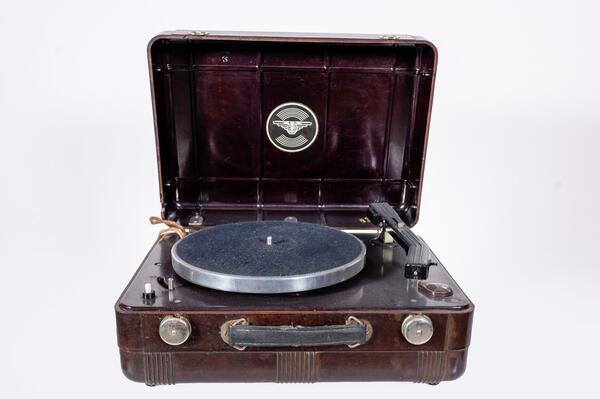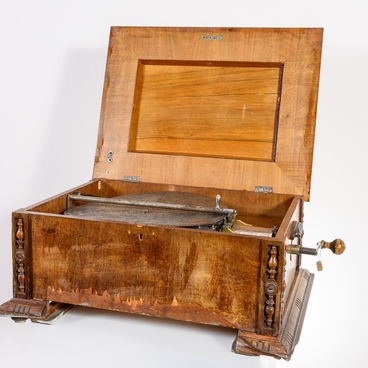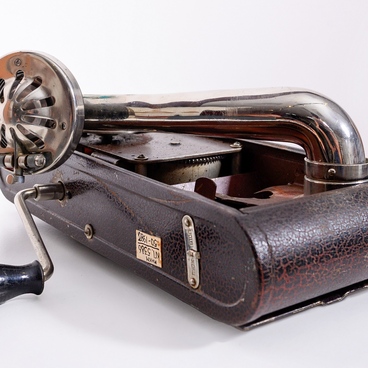In the early 20th century, portable mechanical record players were called phonographs and were shaped like a suitcase with a handle. Such devices were different from gramophones because they did not have an external horn, but instead had one that was built directly into the case.
By the mid-20th century, electric phonographs replaced mechanical gramophones. The first device like that in the USSR was developed in 1932 and got the name “electric radiograph” — abbreviated ERG. It was assumed that it would be mass-produced by the Moscow Radio Factory “Temp”. However, the production did not begin in the 1930s as it was planned, and after the war, in the early 1950s, it was moved to Vilnius, to the Electrotechnical Works “Elfa”.
Electric record players in the Soviet Union did not have a common name for a long time. Such devices were called electric gramophones, electric phonographs, or radio-phonographs. It was only in the 1970s that the official term “electrophone” was assigned to them.
The electric phonograph “Vilnius” from the collection of the National Museum of the Republic of Mari El was able to play both ordinary and long-playing records. These two types differed in the speed of playback: ordinary disks made 78 revolutions per minute, while long-playing ones — 33.
The player consists of an electric motor that drives a massive disc for records, a pickup in the form of a head with a metal needle, a built-in sound membrane, and an amplification system. The case of this model is made of bakelite, a kind of solid plastic. In the USSR, this material was used to make table lamps, telephones, knife handles. At the Konigsberg State Amber Manufacture, bakelite was even used as an inexpensive substitute for natural amber.
The electric phonographs first had gramophone records made of natural resin — shellac. They were quite heavy, but at the same time fragile: they could not be dropped, and gramophone needles easily damaged the soundtrack. In the mid-20th century, factories started to make vinyl phonograph records. This material was stronger, lighter and more durable. As for the music that was not officially released in the USSR, it was recorded homemade on old X-ray photographs. Such homemade records were popularly called music “on the ribs” or “on the bones”.
By the mid-20th century, electric phonographs replaced mechanical gramophones. The first device like that in the USSR was developed in 1932 and got the name “electric radiograph” — abbreviated ERG. It was assumed that it would be mass-produced by the Moscow Radio Factory “Temp”. However, the production did not begin in the 1930s as it was planned, and after the war, in the early 1950s, it was moved to Vilnius, to the Electrotechnical Works “Elfa”.
Electric record players in the Soviet Union did not have a common name for a long time. Such devices were called electric gramophones, electric phonographs, or radio-phonographs. It was only in the 1970s that the official term “electrophone” was assigned to them.
The electric phonograph “Vilnius” from the collection of the National Museum of the Republic of Mari El was able to play both ordinary and long-playing records. These two types differed in the speed of playback: ordinary disks made 78 revolutions per minute, while long-playing ones — 33.
The player consists of an electric motor that drives a massive disc for records, a pickup in the form of a head with a metal needle, a built-in sound membrane, and an amplification system. The case of this model is made of bakelite, a kind of solid plastic. In the USSR, this material was used to make table lamps, telephones, knife handles. At the Konigsberg State Amber Manufacture, bakelite was even used as an inexpensive substitute for natural amber.
The electric phonographs first had gramophone records made of natural resin — shellac. They were quite heavy, but at the same time fragile: they could not be dropped, and gramophone needles easily damaged the soundtrack. In the mid-20th century, factories started to make vinyl phonograph records. This material was stronger, lighter and more durable. As for the music that was not officially released in the USSR, it was recorded homemade on old X-ray photographs. Such homemade records were popularly called music “on the ribs” or “on the bones”.



